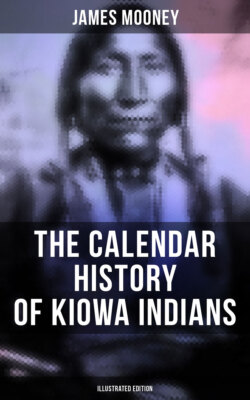Читать книгу The Calendar History of Kiowa Indians (Illustrated Edition) - James Mooney - Страница 40
На сайте Литреса книга снята с продажи.
Traders Among the Kiowa
ОглавлениеTable of Contents
From the statement of Lewis and Clark already noted, it appears that in 1805, while still located on the North Platte, the Kiowa had as yet no communication with traders, but obtained supplies indirectly through the tribes living farther east. From Pike's narrative, however, we learn that James Pursley, "the first American who ever penetrated the immense wilds of Louisiana," spent a trading season with the Kiowa and Comanche in 1802 or 1803, under engagement with a French trader operating from the Mandan country, and remained with them until the next spring, when the Dakota drove them from the plains into the mountains at the heads of the Platte and Arkansas (Pike, 2). From Long's statement, also previously quoted, we learn that in 1815, the Kiowa having drifted farther south in the meantime, traders from St Louis had begun to ascend Arkansas river to trade with the Kiowa, Cheyenne, and other tribes near its headwaters. From other sources it is apparent that before this time they had had dealings also with the Spaniards of New Mexico. The first regular American trading expedition to the Kiowa country was made in 1834 when, on the return of the visiting chiefs from Fort Gibson, a company of eighty trappers and traders went back with them to their homes on the upper Washita and Red rivers (Catlin, 3). In 1835, shortly after the treaty with the Comanche at Camp Holmes, Colonel Auguste Chouteau built on the same site a small stockade fort, where a considerable trade was carried on with the Comanche, Kiowa, Wichita, and associated tribes until his death three years later, when the place was abandoned (Gregg, 1). The exact location of Camp Holmes and Chouteau's fort was at a spring on a small creek, both still bearing the name of Chouteau, on the east or north side of South (main) Canadian river, about 5 miles northeast of where now is the town of Purcell, Indian Territory. It was a favorite Indian camping ground and was the site of a Kichai village about 1850.
Auguste Chouteau, the descendant of one of the early French founders of St Louis, was the pioneer organizer of the Indian trade in the upper Red river country, as were the Bents, also of French origin, on the upper Arkansas. Under the name of Soto, Chouteau is still held in affectionate remembrance by the Kiowa.
Chouteau's fort on the Canadian was considered to be in Comanche territory. Shortly after the treaty with the Kiowa in 1837, he established what they regard as the first trading post within their own country, on the west bank of Cache creek, about 3 miles below the present Fort Sill, Oklahoma. Tomé-te (Thomas?) is the name by which the Kiowa remember the trader in charge, who, however, did not remain long. Another store was established nearly on the same ground by William Madison (Sénpo-zédalbe, "Terrible-beard") in 1869, after the tribes had been assigned to a reservation. In 1844, William Bent began building trading posts on the South Canadian, in the Texas panhandle, near the principal Kiowa trails. They also traded extensively at various points on the Arkansas until their final removal to Indian Territory.
